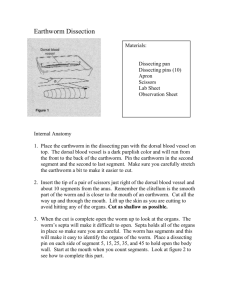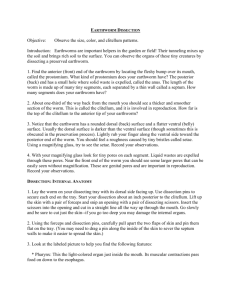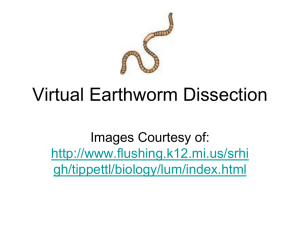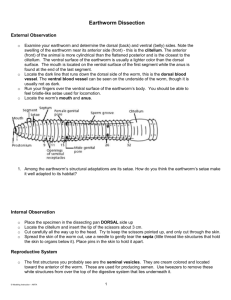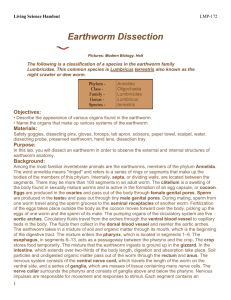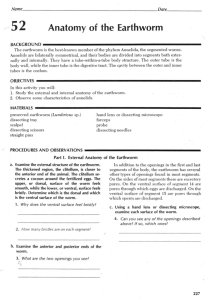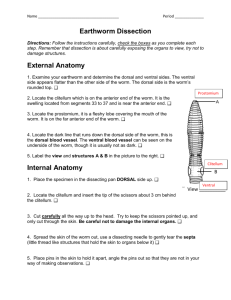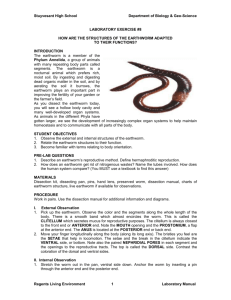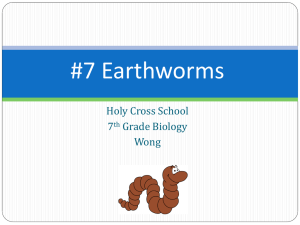The Earthworm Dissection - ScienceCo
advertisement
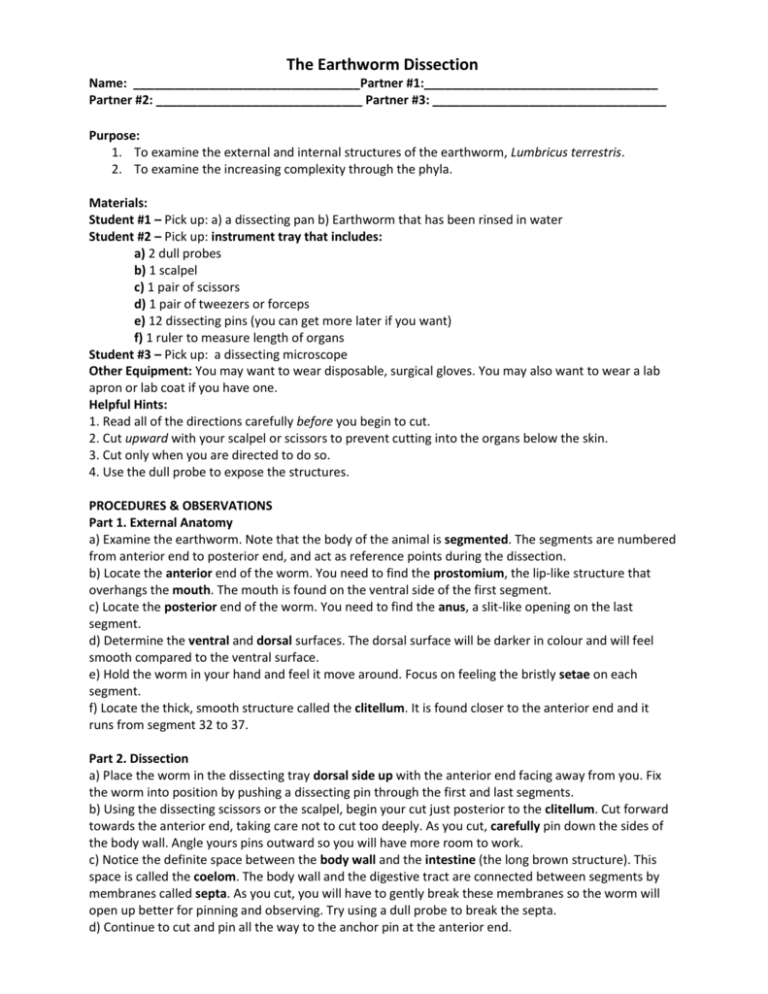
The Earthworm Dissection Name: _________________________________Partner #1:__________________________________ Partner #2: ______________________________ Partner #3: __________________________________ Purpose: 1. To examine the external and internal structures of the earthworm, Lumbricus terrestris. 2. To examine the increasing complexity through the phyla. Materials: Student #1 – Pick up: a) a dissecting pan b) Earthworm that has been rinsed in water Student #2 – Pick up: instrument tray that includes: a) 2 dull probes b) 1 scalpel c) 1 pair of scissors d) 1 pair of tweezers or forceps e) 12 dissecting pins (you can get more later if you want) f) 1 ruler to measure length of organs Student #3 – Pick up: a dissecting microscope Other Equipment: You may want to wear disposable, surgical gloves. You may also want to wear a lab apron or lab coat if you have one. Helpful Hints: 1. Read all of the directions carefully before you begin to cut. 2. Cut upward with your scalpel or scissors to prevent cutting into the organs below the skin. 3. Cut only when you are directed to do so. 4. Use the dull probe to expose the structures. PROCEDURES & OBSERVATIONS Part 1. External Anatomy a) Examine the earthworm. Note that the body of the animal is segmented. The segments are numbered from anterior end to posterior end, and act as reference points during the dissection. b) Locate the anterior end of the worm. You need to find the prostomium, the lip-like structure that overhangs the mouth. The mouth is found on the ventral side of the first segment. c) Locate the posterior end of the worm. You need to find the anus, a slit-like opening on the last segment. d) Determine the ventral and dorsal surfaces. The dorsal surface will be darker in colour and will feel smooth compared to the ventral surface. e) Hold the worm in your hand and feel it move around. Focus on feeling the bristly setae on each segment. f) Locate the thick, smooth structure called the clitellum. It is found closer to the anterior end and it runs from segment 32 to 37. Part 2. Dissection a) Place the worm in the dissecting tray dorsal side up with the anterior end facing away from you. Fix the worm into position by pushing a dissecting pin through the first and last segments. b) Using the dissecting scissors or the scalpel, begin your cut just posterior to the clitellum. Cut forward towards the anterior end, taking care not to cut too deeply. As you cut, carefully pin down the sides of the body wall. Angle yours pins outward so you will have more room to work. c) Notice the definite space between the body wall and the intestine (the long brown structure). This space is called the coelom. The body wall and the digestive tract are connected between segments by membranes called septa. As you cut, you will have to gently break these membranes so the worm will open up better for pinning and observing. Try using a dull probe to break the septa. d) Continue to cut and pin all the way to the anchor pin at the anterior end. Part 3. The Digestive System a) Use the diagrams and your notes to help you identify the various parts of the digestive system. Make sure you use your dull probe to gently touch and point out the various structures. b) The mouth of the earthworm opens into the muscular pharynx. Locate the pharynx (within the first 5 segments) and gently poke it with your probe. Describe its texture or thickness and how it feels. _____________________________________________________________________________________ _____________________________________________________________________________________ Why would the pharynx have a thicker muscular wall than other structures? _____________________________________________________________________________________ _____________________________________________________________________________________ c) Posterior to the pharynx is a narrow tube called the esophagus, which extends for about 10 segments. What is the function of the esophagus? ____________________________________________________ _____________________________________________________________________________________ d) The esophagus widens into the crop. Posterior to the crop is the gizzard. Use the probe to gently poke the crop and gizzard to feel the relative textures and thickness. Describe the crop and give its function. _____________________________________________________________________________________ _____________________________________________________________________________________ _____________________________________________________________________________________ Describe the gizzard and give its function. __________________________________________________ _____________________________________________________________________________________ _____________________________________________________________________________________ _____________________________________________________________________________________ e) From the gizzard, the food passes into the intestine. The intestine extends posterior to the anus. Describe the intestine and identify its function. _____________________________________________________________________________________ _____________________________________________________________________________________ _____________________________________________________________________________________ f) Draw a longitudinal view of the earthworm’s digestive tract. Label the mouth, pharynx, esophagus, crop, gizzard, intestine and anus. Note: you don’t necessarily have to open the entire worm to complete the sketch Part 4. The Circulatory System a) You will have to remove the large white structures that are a part of the reproductive system. Using tweezers or forceps, remove the reproductive structures. b) Locate the dorsal blood vessel that runs along the top of the intestine. Locate the ventral blood vessel that runs underneath the intestine. You will have to push the intestine aside in order to find the ventral blood vessel. Describe the dorsal and ventral blood vessels. _____________________________________________________________________________________ _____________________________________________________________________________________ _____________________________________________________________________________________ _____________________________________________________________________________________ c) In segments 6 to 11 the dorsal and ventral blood vessels are connected by 5 pairs of aortic arches. They are fragile and may have been damaged during the dissection. How many hearts were you able to find? ___________________ Describe the appearance of the 5 pairs of aortic arches. _____________________________________________________________________________________ _____________________________________________________________________________________ _____________________________________________________________________________________ _____________________________________________________________________________________ Describe the direction of the flow of blood in an earthworm. ___________________________________ _____________________________________________________________________________________ _____________________________________________________________________________________ _____________________________________________________________________________________ Is the earthworm circulatory system open or closed? ____________________ Explain. ______________ _____________________________________________________________________________________ _____________________________________________________________________________________ d) Add the dorsal blood vessel, ventral blood vessel and 5 pairs of aortic arches to your diagram. Part 5. The Nervous System a) Locate the yellowish ventral nerve cord. You will have to push the intestine aside again in order to locate the ventral nerve cord. Describe the appearance of the ventral nerve cord. _____________________________________________________________________________________ _____________________________________________________________________________________ _____________________________________________________________________________________ b) Using the dissecting microscope, look at the nerve side branches in each segment. Describe the appearance and function of these branches. _____________________________________________________________________________________ _____________________________________________________________________________________ b) Add the brain and ventral nerve cord to your diagram. Part 6. The Excretory System a) Remove a section of the intestine in order to locate the excretory organs called nephridia. Nephridia are located in pairs on every segment, except for the first 3 segments and the last segment. You will have to use the dissecting microscope to see the nephridia. b) Describe the appearance of the nephridia. ________________________________________________ _____________________________________________________________________________________ _____________________________________________________________________________________ c) What paired organs in our body contain similar structures to the nephridia in the earthworm? ____________ CLEAN UP! If you are finished with the worm (LOOK AT QUESTION 5 BEFORE THROWING OUT), it can be thrown in the garbage. The dissecting pan should be washed with soap and water and turned upside-down to drain. The rest of the dissecting tools should also be washed with soap and water, dried and returned to the appropriate area. When your dissecting pan is dry, place a paper towel in the bottom and make a stack at the front of the class. Discussion Questions: 1. Explain why the movement of the worm in your hand felt like a sort of tickle. 2. What is the function of the setae? 3. Briefly describe the process of cross-fertilization in earthworms. 4. Explain the process of how food is obtained and digested in the earthworm. Include all structures involved. 5. How many segments does your worm have on its entire body? Compare with other groups. Drawings:

